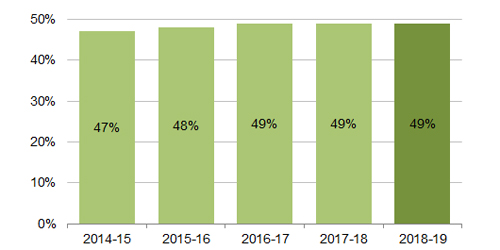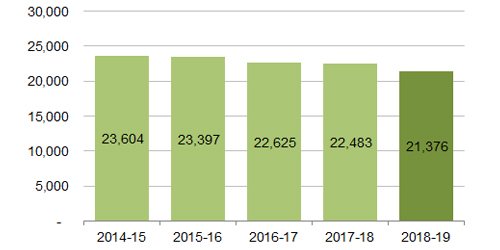Theme 3
The environment
Strategic objective
Our natural environment is healthy and sustainable for future generations.
Key figures
- $22.9 million net operating cost
- 67,468 tonnes of waste collected from kerbside bins
- 43.1ha of land managed for biodiversity.
Achievements
Reduce greenhouse gas emissions
Commitment
Reduce greenhouse gas emissions and energy costs at Council buildings by implementing low emissions technologies and energy efficiency upgrades identified in Council’s Energy Performance Contract.
Project overview
Council operates a number of high-quality facilities, providing a variety of services for our community. These facilities use electricity and natural gas, which produce greenhouse gases and result in high financial costs.
In order to reduce greenhouse gas emissions and energy costs from these large Council buildings, Council implemented the Energy Performance Contract (EPC), investing in cost effective, low emissions technologies and energy efficient upgrades and retrofits to achieve this.
Through the Eastern Alliance for Greenhouse Action the City of Boroondara carried out a cross-council collaboration with Yarra Ranges, Maroondah and Knox to plan and tender the EPC. This collaboration allowed the partners to access a greater pool of expertise, share resources and leverage value from greater buying and negotiation power.
The EPC is performance based, using accepted industry standards, along with low risk, accountable methodology to deliver energy efficiency upgrades to buildings.
The EPC approach allowed Council to achieve substantial savings in energy use and associated greenhouse gas costs. It will also assist in achieving the emissions target included in Council’s Our Low Carbon Future Strategy 2009.
The EPC project has prioritised upgrades at seven sites, Ashburton Pool and Recreation Centre (APARC), Boroondara Sports Complex (BSC), Hawthorn Town Hall, Hawthorn Aquatics and Leisure Centre and the three buildings of the Camberwell Municipal Offices.
Future work with the provider will measure and ensure the delivery of committed savings.
Project aims
The project set out to identify opportunities to improve the energy efficiency of Council buildings, and then act on these opportunities through the delivery of cost effective upgrades. The works were expected to deliver substantial savings in energy use, financial costs and greenhouse gas emissions.
Project outcomes
The works completed in June 2019 delivered the installation of $2.5 million in energy efficiency upgrades across seven of Council’s largest buildings. Works included upgrading pool heating at APARC and BSC to high efficiency boilers, high efficiency lighting upgrades across all sites, Heating Ventilation and Air Conditioning (HVAC) and building management upgrades, and a range of other energy efficiency technologies.
Annually, this is expected to result in savings over $250,000 and 1,760 tonnes in greenhouse gases, meaning that the project will pay for itself within 10 years.
For more information, see Reducing our carbon emissions.
Summary of other achievements
- Supported the formation of a community working group at Willsmere Station Community Garden which has transitioned to a committee of management. This group has participated in the design and development of the new garden and will be responsible for its ongoing operation.
- Council has now completed $2.56 million in energy efficiency upgrades at seven of Council’s largest buildings as part of the Energy Performance contract. These works have been completed over two financial years 2017-18 and 2018-19.
- Collected detailed asset data for 45,000 trees in the City’s parks, providing accessible up to date data about the City’s park trees.
- Implemented the Paperless Office project to eliminate the physical mailing out of Building Permit documentation to applicants for a reduced environmental impact.
Kerbside collection waste diverted from landfill

Tonnes of CO2 emissions from energy used from Council operations

Challenges
Boroondara, like many Victorian Councils, faced significant challenges with ensuring kerbside recycling material was appropriately processed in February 2019 when Melbourne’s primary recycling processing company was closed down by the Environment Protection Authority (EPA). The immediate challenges were to ensure kerbside collections were not interrupted and to minimise recycling sent to landfill.
In addition to the crisis response actions, Council also undertook a range of actions to ensure the problem can be avoided or minimised in the future. This included contributing to the Product Stewardship Act update, and the Parliamentary Inquiry into recycling and waste management. Council initiated a range of communications to residents through our media channels, including a 10-week waste avoidance Facebook campaign, which had 18,807 views.